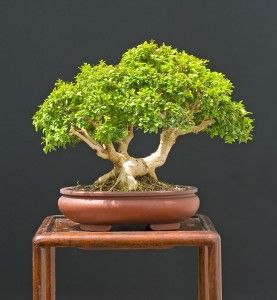 Japanese Boxwood Bonsai are extremely slow growing, making them perfect for bonsai. They also grow very tiny leaves, making it easy to look balanced in miniature form. These trees are typically grown outdoors in warm locations, but indoor in colder locations. These trees need to go dormant for at least three months, but do not do well in below freezing temperatures.
Japanese Boxwood Bonsai are extremely slow growing, making them perfect for bonsai. They also grow very tiny leaves, making it easy to look balanced in miniature form. These trees are typically grown outdoors in warm locations, but indoor in colder locations. These trees need to go dormant for at least three months, but do not do well in below freezing temperatures.
Watering Japanese Boxwood Bonsai
Boxwoods enjoy full sun, which means they will dry out faster than other potted bonsai. Ensure that you check the moisture level daily, watering well when dry. The best way to water a bonsai is to submerge it in a tub of water up to the brim of the pot. Leave it submerged for a few minutes before removing it and allowing excess water to drain out.
Placement of your Japanese Boxwood Bonsai
Boxwood grow best in fully or mostly sunny locations during the growing season. As mentioned above, they need a dormant winter season to survive. If grown indoors, place the plant in a cool dark location for 3 months of the year to simulate a winter. If you are growing this tree outdoors, place the tree in a place that does not get too cold and is not affected by wind chill. A shed or garage that is not heated will work perfectly for this.
Training Japanese Boxwood Bonsai
Trim back new growth to maintain shape and style. Keep in mind that this tree grows very slowly, so don’t trim too much if you think you will need it later. Wiring can be done any time of the year and can be left on for as much time as necessary.
Repotting Japanese Boxwood Bonsai
Repot this species every other year, trimming back ten percent of the surface roots to encourage new growth. This tree will stop growing if it runs out of space to grow roots.
Fertilizing Japanese Boxwood Bonsai
As with any bonsai, fertilizing is vital to supplement the small amount of soil. Feed this tree a balanced fertilizer every other week during the growing season. Slow down to monthly feedings during the fall and winter.
 |
 |
 |